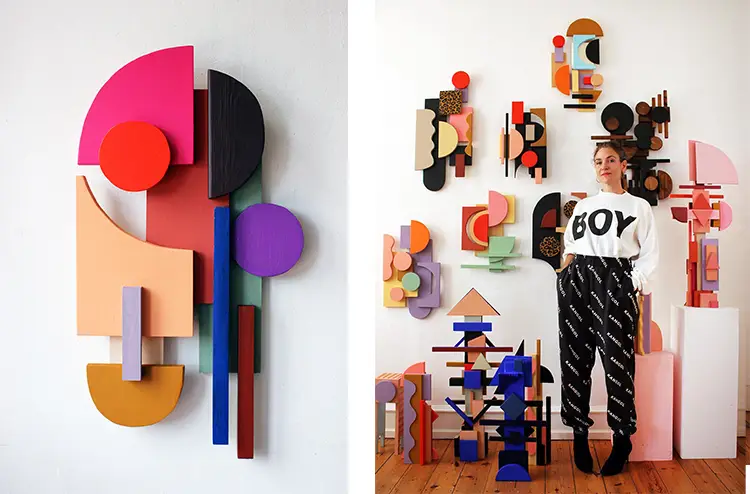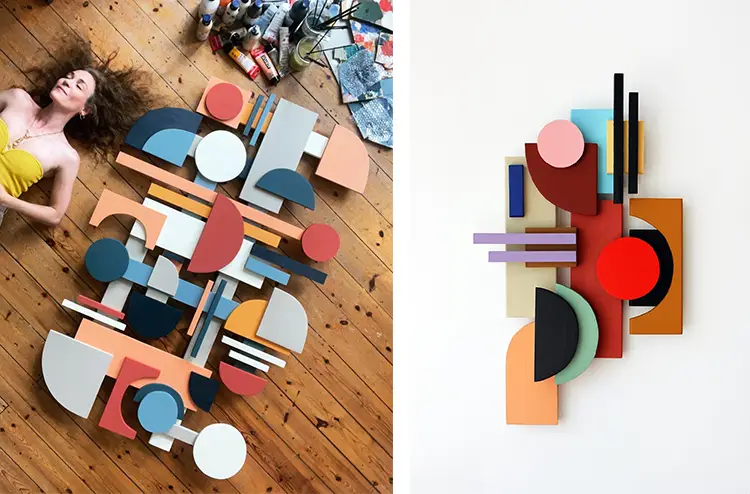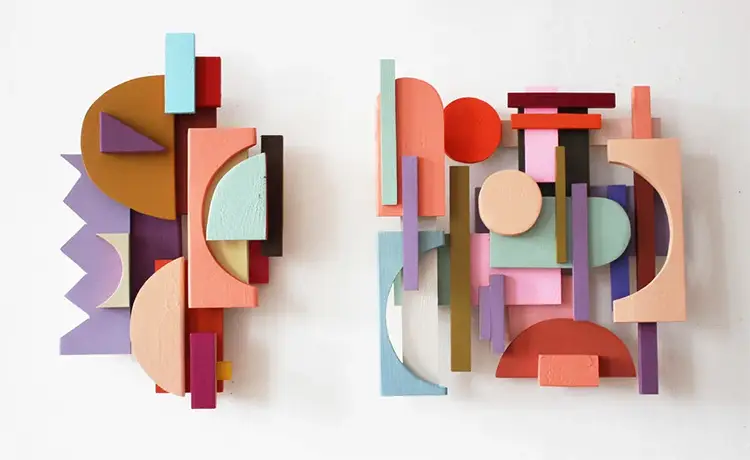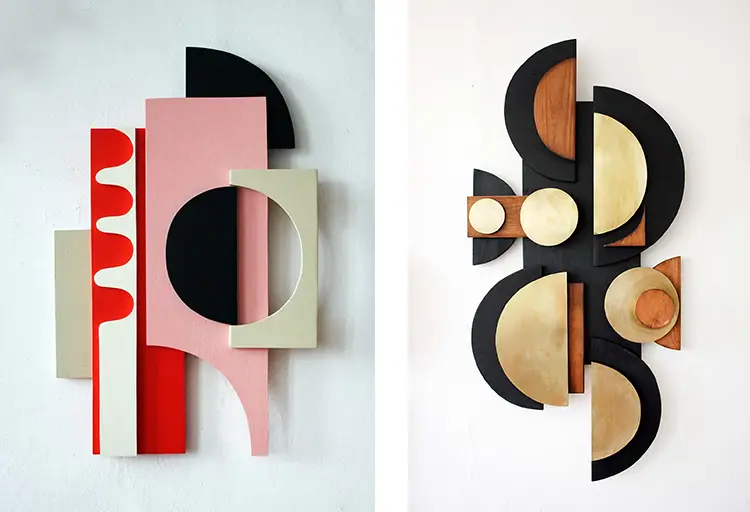The Quiet Force of Contrasts
From the heart of Copenhagen, Tilde Grynnerup emerges as a distinctive voice in contemporary art, operating beyond conventional categories. Her work flows intuitively between photography, textiles, woodworking, installation, and conceptual gestures, creating a language that is both tactile and emotionally resonant. Each piece she creates speaks to a deep inner need to communicate—whether through softness or strength, wit or solemnity. Grynnerup’s approach challenges the tendency to confine an artist to one identity or medium. Her practice embodies flux and intuition, resisting boundaries while staying rooted in her own evolving sense of self.
Grynnerup’s creative life did not begin in a white-walled studio but in the rhythms of music and the structured beauty of textiles. Early on, she explored songwriting as a way to process and share emotion. Later, her education in textile design, particularly embroidery, led her to spend ten years in the fashion industry. Yet even then, she found herself pushing against limitation, yearning for a fuller range of expression. Her departure from fashion marked a return to artistic instinct, allowing her to combine influences from her musical past with her tactile sensibilities, blending softness with conceptual rigor. This multilayered approach remains central to how she creates today.
Rather than committing to a singular medium, Grynnerup prioritizes the integrity of the message. If an idea calls for the warmth of fabric, she responds with thread; if it asks for sturdiness, she turns to wood or brass. The interplay between these materials—between what’s soft and what’s solid—is not a matter of aesthetic preference but a form of dialogue. The tension between opposites becomes a powerful compositional tool, enabling her to craft works that explore vulnerability, humor, indignation, and connection. This intentional friction reflects her broader artistic mission: to remain curious, resist comfort, and stay alive to the world.

Tilde Grynnerup: Freedom as Practice, Not Possession
For Grynnerup, creative freedom is not a given—it’s something to be claimed, protected, and renewed. Her commitment to multidisciplinary exploration stems from a deeply held belief that no one can define how she should express herself except herself. She recalls the quote by Meret Oppenheim, “Nobody will give you freedom. You have to take it,” as a guiding principle that has shaped not only her artistic career but her broader life philosophy. This act of taking freedom—of choosing to follow where curiosity leads—has become central to her identity as an artist. The decision to shift from textile work and music into woodworking was one such bold act of reclamation.
Woodworking, now a prominent feature of her practice, connects her to her roots in a literal sense. Her father, a retired carpenter, introduced her early to the physicality and precision of working with wood. Years later, that influence resurfaced not as nostalgia but as a genuine creative pull. Grynnerup and her father now share a workshop near a small forest outside Copenhagen, where they work side by side. The surrounding nature and quiet are more than just backdrop—they inform her process and offer a balance to the stimulation of city life. Moving between this rural space and her Copenhagen studio has become a rhythm of contrasts, echoing the dualities in her art.
This movement between extremes—natural and urban, soft and hard, solitary and social—feeds into the textures and tones of Grynnerup’s work. Her compositions are often marked by a quiet insistence, a refusal to resolve the contradictions they contain. Whether incorporating soft embroidery into a wooden installation or juxtaposing humor with serious reflection, she invites viewers to engage with the full spectrum of human feeling. Grynnerup resists formulaic repetition, embracing instead the unknown that comes with using new materials or taking emotional risks. For her, freedom is not about endless possibility; it’s about listening closely to what needs to be said and honoring the form it takes.

Crafted Connection Through Story and Humor
Grynnerup’s work often carries emotional weight, but never in a heavy-handed way. She brings forward themes like social injustice, vulnerability, and shared human experience, yet she does so with a lightness that invites rather than overwhelms. Humor becomes a disarming entry point—one that allows her to explore serious ideas without veering into didacticism. This balance between playfulness and depth is what gives her art its particular resonance. Through irony, wit, or tender absurdity, she creates spaces where viewers can feel both challenged and comforted.
Words continue to play a vital role in Grynnerup’s process, a remnant of her earlier life as a songwriter. That sensitivity to language has found new expression in her visual work, sometimes manifesting literally as text integrated into textiles or sculptural pieces. The return to writing has taken on a new dimension in recent years, sparked by her rediscovery of poetry through the writings of Edith Södergran and Mary Oliver. Moved by the emotional clarity of their verses, Grynnerup enrolled in a poetry class—not to become a poet per se, but to reconnect with a forgotten part of herself. This act of rekindling became another thread in her multidimensional practice.
Despite her focus on deeply personal expression, Grynnerup’s art is never closed off or insular. Her aim is to connect—not just to herself, but to others. The sense of shared recognition, of mutual “aha” moments or quiet reflection, is what she seeks in her audience. Exhibiting internationally in cities like Paris, London, and Seoul has only reinforced that goal. The diversity of responses she receives across cultures affirms the universality of the questions she asks through her work: How do we make meaning? How do we live alongside each other? Where can we find relief, laughter, or wonder amid the chaos of modern life?

Tilde Grynnerup: Wonder as a Way of Living
Wonder is not merely a theme in Grynnerup’s art—it is the very engine of her creative life. Whether through the tactile surprise of combining wood and fabric, the emotional echo of a phrase stitched into cloth, or the unexpected smile drawn from a viewer, her work begins in curiosity. She sees art as a way of asking rather than answering—a continuous unfolding of questions, feelings, and forms. This sensibility informs everything she makes and everything she is. For her, being an artist isn’t a title but a mode of existence: one that permits contradiction, vulnerability, and growth.
Astrology offers another lens through which Grynnerup examines her life and work. Identifying as a Virgo with Sagittarius rising, she regularly consults an astrologer as a means of navigating important decisions. Far from using it as a deterministic tool, she views astrology as a way to better understand her inner rhythms and align her creative efforts with broader cycles. It’s one more method of tuning into the flow of her life, of recognizing when to act and when to reflect. In a practice defined by balance—between thought and feeling, city and forest, discipline and spontaneity—astrology offers her a symbolic compass.
When asked what it means to be an artist today, Grynnerup speaks simply and directly: it means being honest. Honest with herself, with her materials, and with the people who encounter her work. That honesty, she believes, is what allows her to connect on a human level. Art, for her, is a way to express what’s difficult to say in ordinary language—a way to offer not just ideas but relief. Whether through a shared laugh or a moment of silent recognition, that emotional exchange is what drives her. In a world full of noise, Grynnerup’s practice is a quiet yet insistent call to pause, to feel, and above all, to wonder.








